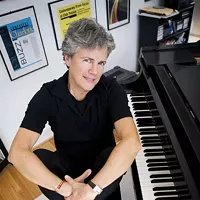Running Circles
Around the faux art world
For years, Thomas Sayre has made his living selling circles and, from time to time, the occasional square. Sometimes he stacks the circles on top of each other to form cucumberesque shapes. Other times they are freestanding.
Government art bureaucrats love Sayre's circles and have paid him hundreds of thousands of dollars for them over the years.
The vaunted, highly qualified art critics with Charlotte Area Transit System's art-in-transit program call Sayre an artist. The head of the art program, which bought $142,000 worth of orange discs from him for the South Corridor light rail line, told me he was brilliant a few years ago. I agreed with her that he was brilliant. Not a brilliant artist, but a brilliant marketer who is running one heck of a racket.
Sayre's modus operandi is the same in many of the cities and states he has worked in. He meets with people from the area to find out about the history of the place, then builds them "sculptures" that look remarkably like the ones he has done elsewhere. He then concocts a different back story for each piece or claims it represents some unique aspect of local history.
In Charlotte, the Observer reported, Sayre met with Scaleybark area residents who said they wanted artwork that recalled a past when farms covered ground now dotted with subdivisions and strip development. So Sayre built us big orange disks whose color he claims represents the "classic North Carolina red clay color." One problem. The similar-looking disks he's doing in Oregon and proposed for the Indianapolis Airport are the same color and texture.
Sayre calls the disks along the light rail line on South Boulevard "Furrow" and says they recall the harrowing disks farmers around here used to use for planting. In Indianapolis, Sayre called near identical art disks he proposed for an airport art project "Harrow" rather than "Furrow" and said they represented the wheel, the symbol of the progress of humankind and the emblem of transportation. The airport ultimately nixed the project, but not before Sayre produced pictures of what it would have looked like, pictures that show virtually identical disks to the ones now up and down South Boulevard.
Sayre claims the other near-identical looking disks he is doing for the University of Oregon's Living-Learning Center are "reminiscent of the organic shapes of leaves" and will "link the organic/industrial chasm," whatever that means, and act as "reminders of the earth's essential elements."
For mass producing these sculptures and claiming they represent some abstract aspect of history, Sayre has been paid hundreds of thousands of taxpayer dollars.
Three years ago, when I first introduced Sayre to my readers, he was coming out of what I call his "cucumber phase" and was well into his "circles phase."
Many of the 10- to 20-foot cucumberesque sculptures he did in the cucumber phase bear a striking resemblance to each other in form, yet Sayre has a different spin for each one.
The legume-like stack of black concrete circles he created for Atlanta's Hartsfield Airport in Atlanta is supposed to represent "the mystery of night," Sayre said. In St. Petersburg, Fla., a similar stack of circles by Sayre sits outside a fire station. Sayre claims that the sculpture, for which the St. Petersburg Public Art Commission paid $50,000, represents "the historical architectural element of a fire station hose tower." Outside a public building in Raleigh, a grouping of 24 skinnier cucumbers represent North Carolina's 24 largest cities, Sayre said. But again, it's basically similar pieces over and over again, with a different intellectual explanation by the artist for what it means.
Then there was Sayre's big circle phase. Evidence of this can be found on the corner of Wendover and Randolph roads in Charlotte, where two now infamous massive earth-tone circles jut from the ground. Sayre claimed those structures, which he called "Grandiflora," were inspired by the petals in trees' seed pods. Sayre called the strikingly similar, slightly rounder set of massive circles he sold to the North Carolina Museum of Art in Raleigh "Gyre." He claimed that project's name was derived from the work of poet W.B. Yates, who conceived of history as the complex movement of a spiral.
To be fair, Sayre has done some terrazzo work, like that on the floor of the Bobcats arena, that is attractive, intricate and unique. But some of his more mass-produced pieces just seem a bit disingenuous to me. And I'm baffled as to why public art commissions keep buying them.
When asked about his similar projects in other cities by WBTV news after I pointed the pattern out on my blog, Sayre suggested that since his critics -- i.e. me -- weren't "artists," they weren't qualified to judge his work. He also said that the real reason for the criticism was a local disdain by some for light rail, and suggested their criticism did "violence" to both his work and the light rail line.
The way I see it, my criticism of Sayre's work is journalism, and I don't see a journalism degree on his resume. That means that by his own standards, Sayre isn't qualified to criticize my criticism of his work.
So there.
Speaking of 3.67000
-
'Tis the season for parties
Dec 12, 2007 -

Local composer to hold master class, performance
Nov 28, 2007 -
Concert to benefit local poor, homeless
Nov 14, 2007 - More »











